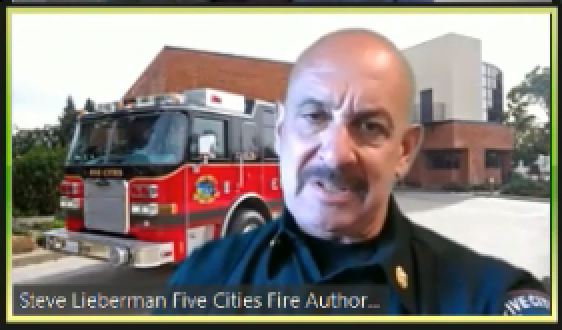Five Cities Fire Authority delays raises because of disclosure failures
May 19, 2020

Fire Chief Stephen Lieberman
By KAREN VELIE
The Five Cities Fire Authority Board delayed plans last week to give raises and bonuses to all fire personnel, allowing Arroyo Grande Councilman Keith Storton time to comply with his city’s requirement to get council approval to spend more than $10,000.
While government shortfalls are leading to reductions in pay and layoffs, fire authority staff is seeking a 2 percent pay increase, and a one-time lump sum payment of $1,000 per employee. In contrast, state fire personnel are receiving 10 percent reductions in pay because of issues related to the coronavirus.
The fire authority is made up of three member agencies: Arroyo Grande, Grover Beach and the Oceano Community Services District, all of which are currently facing financial hardships because of the pandemic.
During last week’s fire authority meeting, Oceano representative Karen White argued that they had already budgeted the raises and bonuses into their prospective budgets.
The matter “has already been approved,” White said.
Nevertheless, Storton argued that the public needed to fully understand the impacts of the raises and bonuses as they relate to the “Covid budget.” Recently, Arroyo Grande initiated furloughs and hiring and travel freezes, and deferred project maintenance. In order to implement the proposed raises and bonuses, all three members of the board would have to vote to approve.
Of the fire authority’s 32 fire personnel, 15 make over $150,000 a year in salary and benefits, according to Transparent California.
Fire authority’s top earners:
- Fire Engineer Joseph Silva – $219,130
- Fire Chief Stephen Lieberman – $218,514
- Fire Captain Paul Quinlan – $218,165
- Fire Captain Brian Leathers – $207,459
- Fire Battalion Chief Brian Salce – $200,152
- Fire Captain Patric Ferguson – $198,007
- Fire Battalion Chief Riki Heath – $190,608
- Fire Captain John Bova – $186,826
Decades ago, with improved fire prevention methods, fire departments began focusing on health care emergencies in order to fund their agencies. Currently, firefighters respond to medical calls first, while ambulance drivers delay their response for five minutes. If there is a medical emergency requiring transportation, the ambulance medics take over medical care and transport the patient to a hospital.
Critics have questioned the efficiency of the system.
And as the controversy over the cost versus the benefits of having firefighters respond to all medical calls heats up, several communities in California have switched or are in the process of switching to a system where private ambulance personnel respond to most medical calls without dispatching fire trucks and safety workers.
For example, during contract negotiations 14 years ago, San Joaquin County adopted the practice of sending out the “correct resource” for each emergency call, either a fire truck or an ambulance.
“If you send the cavalry to each call, even if they are not needed, they may not be available when you need them,” said Dan Burch, San Joaquin County’s director of Emergency Services, who also noted the cost savings of not rolling out unneeded vehicles for each call.
Burch said the change saved taxpayer dollars, while also improving quality of care as patients receive continuous care from the original medics.
Sign up for breaking news, alerts and updates with the Cal Coast News Top Stories.






The comments below represent the opinion of the writer and do not represent the views or policies of CalCoastNews.com. Please address the Policies, events and arguments, not the person. Constructive debate is good; mockery, taunting, and name calling is not. Comment Guidelines